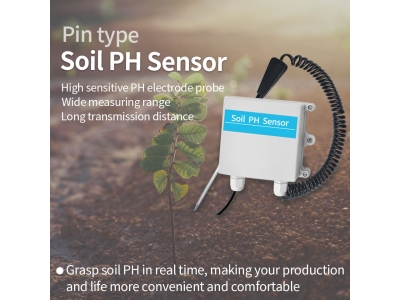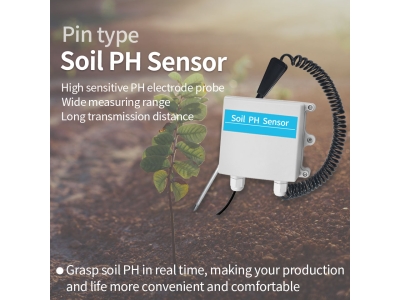In an era where global food demand is increasing, optimizing crop yield has become a paramount concern for modern agriculture. One key factor that significantly influences crop productivity is soil health. By understanding the soil's characteristics and providing tailored interventions, farmers can maximize their yields while minimizing environmental impact. Soil sensors have emerged as powerful tools that enable real-time monitoring of soil conditions, allowing farmers to make informed decisions and optimize crop yield. In this article, we will explore the impact of soil sensors in modern agriculture and their role in enhancing soil management practices.

Understanding the Importance of Soil Health:
Soil health is crucial for crop growth and productivity. Healthy soil provides essential nutrients, water retention capacity, and a favorable environment for root development. However, soil quality can be affected by various factors, including nutrient deficiencies, pH imbalances, salinity, and compaction. Monitoring these parameters and maintaining optimal soil conditions are vital for sustainable and high-yielding agricultural practices.
Role of Soil Sensors in Soil Health Monitoring:
Soil sensors are devices that measure various soil parameters, including moisture content, temperature, nutrient levels, pH, and electrical conductivity. These sensors utilize different technologies, such as capacitance, TDR (Time Domain Reflectometry), and optical sensors, to collect data on soil conditions. The collected data is then used to assess the soil's health and guide farmers in making informed decisions regarding irrigation, fertilization, and other soil management practices.
nhancing Soil Management Practices:
The integration of soil sensors into agricultural practices has revolutionized soil management. Here are some significant impacts of soil sensors on optimizing crop yield:
3.1 Precision Irrigation:
Soil sensors provide real-time data on soil moisture levels, enabling farmers to implement precision irrigation techniques. By understanding the soil's water-holding capacity and moisture distribution, farmers can tailor their irrigation schedules and amounts accordingly. This reduces water wastage, improves water use efficiency, and prevents issues such as overwatering or drought stress, ultimately leading to optimized crop yield.
3.2 Nutrient Management:
Soil sensors play a vital role in optimizing nutrient management practices. By measuring nutrient levels in the soil, farmers can adjust their fertilizer applications to meet crop requirements accurately. This helps prevent under or over-fertilization, reduces nutrient runoff into water bodies, and minimizes environmental pollution. Optimal nutrient management ensures that crops receive the nutrients they need for healthy growth, leading to improved yields.
3.3 pH and Salinity Control:
Soil sensors provide real-time data on soil pH and salinity levels. This information is essential for maintaining optimal conditions for crop growth. By monitoring pH and salinity, farmers can take corrective actions, such as adjusting pH levels or implementing soil leaching techniques, to create favorable soil conditions. This enhances nutrient availability and uptake by plants, allowing for improved crop yields.
3.4 Decision Support Systems:
The data collected by soil sensors can be integrated into decision support systems (DSS) or smart farming platforms. These systems analyze the data and provide recommendations to farmers based on agronomic models and best practices. By utilizing DSS, farmers can make informed decisions about soil management practices, thereby optimizing crop yield and minimizing resource wastage.
Sustainable Agriculture and Environmental Protection:
Soil sensors contribute to sustainable agriculture practices and environmental protection. By providing real-time data on soil conditions, these sensors help minimize the use of water, fertilizers, and other inputs, reducing the risk of nutrient runoff and groundwater contamination. Additionally, by optimizing crop yield, soil sensors enable farmers to produce more food on limited land, helping to meet the growing global demand while minimizing the expansion of agricultural areas into natural habitats.
Future Prospects and Challenges:
While soil sensors have demonstrated significant benefits in optimizing crop yield, challenges remain for their widespread adoption. These include the cost of sensor installation and maintenance, data management, and ensuring sensor accuracy and reliability. Overcoming these challenges requires collaboration between stakeholders, including farmers, researchers, and technology developers, to develop cost-effective solutions and standardized protocols for sensor deployment.
Conclusion:
Soil sensors have revolutionized soil management practices in modern agriculture by enabling real-time monitoring and analysis of soil conditions. By providing accurate and timely data on moisture levels, nutrient availability, pH, and salinity, these sensors empower farmers to make informed decisions regarding irrigation, fertilization, and other soil management practices. The integration of soil sensors contributes to optimized crop yield, sustainable agricultural practices, and environmental protection. As technology continues to advance, soil sensors hold immense potential for enhancing soil health and contributing to the development of a more sustainable and productive agricultural sector.






